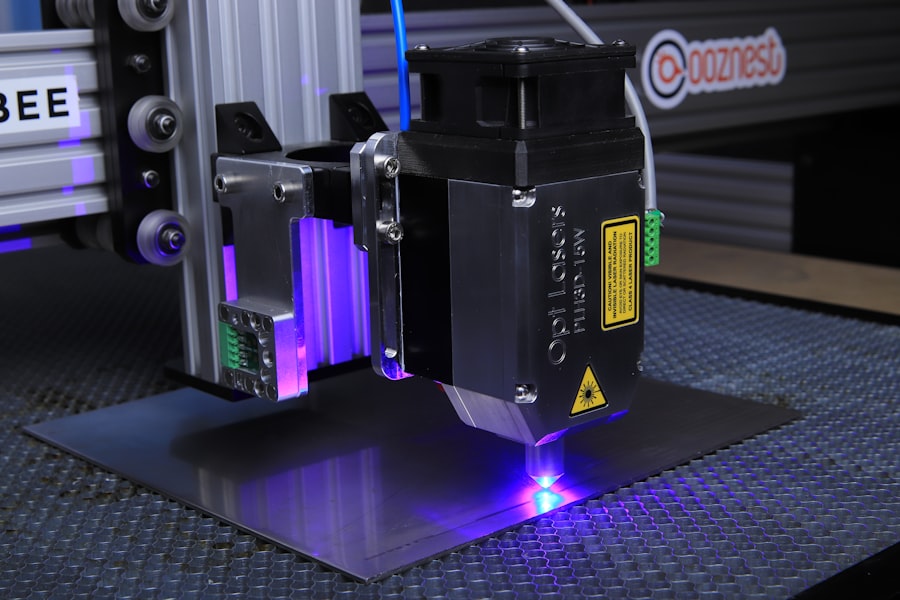Laser hair removal is a popular cosmetic procedure that uses a concentrated beam of light (laser) to remove unwanted hair. This procedure is a non-invasive and long-term solution for reducing or eliminating hair on various parts of the body. The laser targets the pigment in the hair follicles, heating them up and damaging the follicle to inhibit future hair growth. This results in smooth, hair-free skin that can last for an extended period of time.
Laser hair removal is a safe and effective alternative to traditional methods of hair removal such as shaving, waxing, and plucking. It is commonly used to treat areas such as the legs, underarms, bikini line, face, and back. The procedure can be performed by trained professionals in medical spas, dermatology clinics, and cosmetic surgery centers. Laser hair removal has gained popularity due to its long-lasting results and minimal discomfort compared to other hair removal methods.
Key Takeaways
- Laser hair removal is a cosmetic procedure that uses a concentrated beam of light to remove unwanted hair.
- The laser targets the pigment in the hair follicle, damaging it and inhibiting future hair growth.
- Laser hair removal is generally considered safe when performed by a qualified and experienced professional.
- Common treatment areas include the legs, underarms, bikini line, face, and back.
- During a laser hair removal treatment, patients can expect to feel a mild stinging or snapping sensation.
How Does Laser Hair Removal Work?
Laser hair removal works by targeting the pigment in the hair follicles with a concentrated beam of light. The pigment, known as melanin, absorbs the light and converts it into heat. This heat damages the hair follicle, inhibiting future hair growth. The procedure is most effective on hair that is in the active growth phase, as this is when the hair follicle is most responsive to the laser treatment.
During the procedure, the technician will adjust the laser to match your skin tone and hair color to ensure the most effective treatment. Multiple sessions are typically required to achieve the best results, as hair grows in different cycles and not all follicles will be in the active growth phase at the same time. Laser hair removal is a precise and targeted method of hair removal that can selectively target dark, coarse hairs while leaving the surrounding skin undamaged.
Is Laser Hair Removal Safe?
Laser hair removal is considered a safe procedure when performed by a trained and experienced professional. The procedure has been approved by the FDA for “permanent hair reduction,” meaning that it can significantly reduce hair growth but may not result in complete and permanent removal of all hair in the treated area. The safety of laser hair removal largely depends on the skill and expertise of the technician performing the procedure, as well as the quality of the equipment used.
While laser hair removal is generally safe, there are some potential risks and side effects to be aware of, including skin irritation, redness, and changes in skin pigmentation. It is important to discuss any concerns or medical conditions with your technician before undergoing laser hair removal to ensure that it is a suitable option for you. Additionally, it is crucial to follow pre- and post-treatment care instructions to minimize the risk of complications and achieve the best results.
What Areas of the Body Can Be Treated with Laser Hair Removal?
| Area of the Body | Description |
|---|---|
| Face | Laser hair removal can be used to treat unwanted facial hair, including the upper lip, chin, and cheeks. |
| Arms | Both the upper arms and lower arms can be treated with laser hair removal to reduce or eliminate hair growth. |
| Underarms | Laser hair removal is commonly used to remove underarm hair, providing long-lasting smoothness. |
| Legs | From the thighs to the calves, laser hair removal can effectively target and reduce hair growth on the legs. |
| Bikini Area | Laser hair removal can be used to treat the bikini line, reducing the need for regular shaving or waxing. |
| Back | Both upper and lower back hair can be treated with laser hair removal, providing a smoother appearance. |
| Chest | Laser hair removal can be used to reduce or eliminate chest hair for a more groomed look. |
Laser hair removal can be performed on almost any area of the body where unwanted hair is present. Common treatment areas for women include the legs, underarms, bikini line, face (including upper lip and chin), arms, and back. For men, popular treatment areas include the back, chest, shoulders, neck, and face (including beard shaping). Laser hair removal is versatile and can effectively target large or small areas of the body with precision.
The versatility of laser hair removal makes it a popular choice for individuals looking for a long-term solution to unwanted hair. It offers a convenient and efficient way to achieve smooth, hair-free skin without the need for frequent maintenance or upkeep. Whether you are looking to address specific areas of concern or achieve comprehensive hair reduction across multiple areas of the body, laser hair removal can be tailored to meet your individual needs.
What Should I Expect During a Laser Hair Removal Treatment?
During a laser hair removal treatment, you can expect to wear protective eyewear to shield your eyes from the laser light. The technician will adjust the laser equipment according to your skin tone and hair color before beginning the treatment. A cooling gel or numbing cream may be applied to the treatment area to minimize discomfort during the procedure.
As the laser is applied to the skin, you may feel a sensation of heat or tingling as the light energy targets the hair follicles. The duration of each treatment session will depend on the size of the area being treated, with smaller areas such as the upper lip taking only a few minutes, while larger areas like the legs may take up to an hour. After the treatment, you may experience temporary redness or swelling in the treated area, which typically subsides within a few hours.
How Many Sessions Will I Need for Laser Hair Removal?

The number of sessions required for laser hair removal varies depending on factors such as your skin type, hair color, and the area being treated. Most individuals will need multiple sessions to achieve optimal results due to the natural growth cycle of hair follicles. On average, 6-8 sessions spaced 4-6 weeks apart are recommended for significant hair reduction.
It is important to follow the recommended treatment schedule provided by your technician to ensure that all hair follicles are effectively targeted during their active growth phase. While some individuals may see noticeable results after just a few sessions, others may require additional treatments to achieve their desired level of hair reduction. Your technician will assess your progress throughout the treatment process and make any necessary adjustments to ensure that you are on track to achieve your desired results.
What Are the Potential Side Effects of Laser Hair Removal?
Like any cosmetic procedure, laser hair removal carries some potential risks and side effects. Common side effects may include temporary redness, swelling, and mild discomfort in the treated area. Changes in skin pigmentation or blistering are rare but possible side effects that should be discussed with your technician before undergoing treatment.
It is important to follow post-treatment care instructions provided by your technician to minimize the risk of complications and ensure a smooth recovery. This may include avoiding sun exposure, using gentle skincare products, and refraining from activities that could irritate the treated area. By following these guidelines and communicating any concerns with your technician, you can help minimize potential side effects and achieve optimal results from your laser hair removal treatments.
In conclusion, laser hair removal is a safe and effective method for reducing or eliminating unwanted hair on various areas of the body. The procedure works by targeting the pigment in the hair follicles with a concentrated beam of light, damaging the follicle to inhibit future hair growth. While laser hair removal is generally safe, it is important to discuss any concerns or medical conditions with your technician before undergoing treatment. Multiple sessions are typically required to achieve optimal results, and potential side effects may include temporary redness, swelling, and changes in skin pigmentation. By following pre- and post-treatment care instructions and communicating openly with your technician, you can minimize potential risks and achieve smooth, long-lasting results from laser hair removal.
If you’re considering laser hair removal, you probably have a lot of questions. From wondering about the effectiveness of permanent ear hair removal cream to concerns about when hair will grow back after treatment, it’s natural to seek answers. One common question is about the best moisturizer to use after laser hair removal. To find out more about this topic, check out this informative article on the best moisturizer after laser hair removal.
FAQs
What is laser hair removal?
Laser hair removal is a cosmetic procedure that uses a concentrated beam of light (laser) to remove unwanted hair. The laser targets the pigment in the hair follicles, damaging them and inhibiting future hair growth.
How does laser hair removal work?
During the procedure, the laser emits a light that is absorbed by the pigment in the hair follicles. This damages the follicles and inhibits future hair growth. Multiple sessions are usually required to achieve long-term hair reduction.
Is laser hair removal permanent?
Laser hair removal can lead to long-term hair reduction, but it is not always permanent. Some hair may eventually grow back, but it is typically finer and lighter in color.
What areas of the body can be treated with laser hair removal?
Laser hair removal can be used to treat unwanted hair on various areas of the body, including the face, legs, arms, underarms, bikini line, and back.
Is laser hair removal safe?
When performed by a qualified and experienced professional, laser hair removal is generally considered safe. However, there are potential risks and side effects, such as skin irritation, redness, and changes in skin pigmentation.
How many laser hair removal sessions are needed?
The number of sessions needed for laser hair removal varies depending on factors such as the individual’s hair color and thickness, as well as the treatment area. Typically, multiple sessions spaced several weeks apart are required to achieve optimal results.
Who is a good candidate for laser hair removal?
Laser hair removal is most effective for individuals with light skin and dark hair, as the laser targets the pigment in the hair follicles. However, advancements in technology have made it possible for individuals with a wider range of skin and hair colors to undergo laser hair removal. It is best to consult with a qualified professional to determine if you are a good candidate for the procedure.






